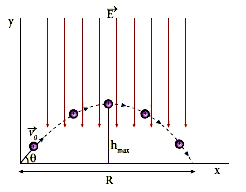A small ball of conducting material having a charge +q and mass m is thrown upward at an angle to horizontal surface with an initial speed as shown in the figure. There exists an uniform electric field E downward along with the gravitational field g. Calculate the range, maximum height and time of flight in the motion of this charged ball. Neglect the effect of air and treat the ball as a point mass.

If the conductor has no net charge, then its motion is the same as usual projectile motion of a mass m which we studied in Kinematics
Here, in this problem, in addition to downward gravitational force, the charge also will experience a downward uniform electrostatic force.
The acceleration of the charged ball due to gravity
The acceleration of the charged ball due to uniform electric field
The total acceleration of charged ball in downward direction
Topper's Solved these Questions
- ELECTROSTATICSBook:NCERT TAMILChapter:ELECTROSTATICSExercise:EVALUATION (Multiple choice questions)
Explore 15 Videos
- ELECTROSTATICSBook:NCERT TAMILChapter:ELECTROSTATICSExercise:Exercises
Explore 23 Videos
- ELECTROSTATIC POTENTIAL AND CAPACITANCE Book:NCERT TAMILChapter:ELECTROSTATIC POTENTIAL AND CAPACITANCE Exercise:ADDITIONAL EXERCISES
Explore 1 Video
- MAGNETISM AND MAGNETIC EFFECTS OF ELECTRIC CURRENTBook:NCERT TAMILChapter:MAGNETISM AND MAGNETIC EFFECTS OF ELECTRIC CURRENTExercise:EVALUATION (IV. Numerical problems)
Explore 10 Videos
Similar Questions
Knowledge Check
A ball is thrown at an angle θ with the horizontal and the range is maximum. The value of tanθ is:-
A1B√3C1√3D2A ball of mass 'm' is thrown at an angle is 'θ' with the horizontal with an initial velcoity 'u'. The change in its momentum during its flight in a time interval of 't' is .
AmgtBmgtcosθCmgt sinθD½mgtA ball of mass 'm' is thrown at an angle is 'θ' with the horizontal with an initial velocity 'u'.The change in its momentum during its flight in a time interval of 't' is
AmgtBm>cosθCm>sinθD1/2m>.
A ball is thrown with speed u at an angle θ with horizontally. After how much time it will move perpendicular to the initial direction of motion.
View SolutionA charged ball with mass m and charge q is dropped from a height h over a non-conducting smooth horizontal plane. There exists a uniform electric field E0 in vertically downward direction and the coefficient of restitution between the ball and the plane is e. Find the maximum height attained by the ball after nth collision.
View SolutionA particle of mass m and charge q is thrown with initial velocity v0 at an angle with the horizontal. In space there exist an electric field of strength E at angle β with the downward vertical away from the point of projection. Find the time of flight and range of projectile on horizontal ground
View SolutionA ball moving is thrown at an angle of 60∘ with the horizontal , with initial speed of 30m/s . Calculate
(a) time of flight of the ball
(b) hrizontal range .
(c) maximum height attained .
View SolutionA ball of mass m is thrown vertically upwards. Another ball of same mass is thrown at an angle θ to the horizontal. If the time if flights for both is same, the ratio of maximum height attained by them
View Solution
